ARoseforEmily英文分析及简评
ARoseforEmily翻译研究

A Rose for EmilyWilliam Faulkner【原文解读】过去几年一直在讲《英美短篇小说解读与译赏》(自编讲义),每讲一次,对福克纳的这篇小说都有一种新的认识,都有一种翻译的冲动,一旦动笔翻译,便在标题上卡壳了。
但正式决定要试着翻译这篇小说而收集相关评论时,才发现此篇小说早已有人译为《献给爱米丽的玫瑰》。
许多评论家都对此篇小说的主题给出了不同的看法,并找出了各种理由一定要“献给”爱米丽玫瑰。
其最终原因,他们的解读因为根据汉语译文标题《献给爱米丽的玫瑰》。
为什么一定要“献给”爱米丽的玫瑰”呢?爱米丽因为什么而值得“献给”玫瑰呢?这是专家们喜闻乐道、争论不断的话题。
尽管如此,仍然禁不住原文小说的诱惑,也禁不住想亲自动手翻译的冲动。
专家们对小说容的分析给自己的翻译提供不少的理解上的帮助;他们的论争也同时加深了自己对原文的理解。
此篇小说翻译理解时,参阅过肖明翰博士对此篇小说的研究论文(肖明翰,再谈《献给爱米丽的玫瑰》———答新民先生,师大学学报社会科学版2000年1月)。
他认为,此篇小说试图说明杰弗逊镇上的人及其以清教思想为核心的旧传统是造成爱米丽的悲剧的真正原因。
【翻译津要】尽管原文标题有寓意,但寓意如何,因人而已。
不同的人往往会有不同的理解。
这就是为什么不同的学者对这篇小说有不同的解读。
毕竟理解是一种阐释过程,但凡阐释必有主观性,翻译也是一种阐释,也必有译者的主观性。
从翻译的角度和读者的角度,个人感觉标题译为“悲情玫瑰”更好,因为全文中唯一出现rose(玫瑰)的地方是小说的第五部分中(171)A thin, acrid pall as of the tomb seemed to lie everywhere upon this room decked and furnished as for a bridal: upon the valance curtains of faded rose color, upon the rose-shaded lights, upon the dressing table, upon the delicate array of crystal and the man’s toilet things backed with tarnished silver, silver so tarnished that the monogram was obscured.其中rose一共出现过两次:rose color和rose-shaded lights。
A-Rose-for-Emily-英文分析及简评

A-R o s e-f o r-E m i l y-英文分析及简评本页仅作为文档封面,使用时可以删除This document is for reference only-rar21year.March“A Rose for Emily” is divided into five sections.The first section opens with a description of the Grierson house in Jefferson. The narrator mentions that over the past 100 years, Miss Emily Grierson’s home has fall into disrepair and become “an eyesore among eyesores.” The first sentence of the story sets the tone of how the citizens of Jefferson felt about Emily: “When Miss Emily Grierson died, our whole town went to the funeral: the men through a sort of respectful affection for a fallen monument, the women mostly out of curiosity to see the inside of her house, which no one save an old manservant – a combined gardener and cook –had seen in at least ten years.”It is known around town that Emily Grierson has not had guests in her home for the past decade, except her black servant who runs errands for her to and from the market. When a new city council takes over, however, they begin to tax her once again. She refuses to pay the taxes and appear before the sheriff, so the city authorities invite themselves into her house. When confronted on her tax evasion, Emily reminds them that she doesn't have to pay taxes in Jefferson and to speak to Colonel Sartoris, although he had died 10 years before.In section two, the narrator explains that the Griersons had always been a very proud Southern family. Mr. Grierson, Emily’s father, believes no man is suitable for his daughter and doesn't allow her to date. Emily is largely dependent upon her father, and is left foundering when he dies. After Mr. Grierson's death, Emily does not allow the authorities to remove his body for three days, claiming he is still alive. She breaks down and allows authorities to take the body away for a quick burial.Section three introduces Emily’s bea u, Homer Barron, a foreman from the north. Homer comes to Jefferson with a crew of men to build sidewalks outside the Grierson home. After Emily and Homer are seen driving through town several times, Emily visits a druggist. There, she asks to purchase arsenic. The druggist asks what the arsenic is for since it was required of him to ask by law. Emily does not respond and coldly stares him down until he looks away and gives her the arsenic. When Emily opens the package, underneath the skull and bones sign is written, "For Rats."Citizens of Jefferson believe that Miss Emily is going to commit suicide since Homer has not yet proposed in the beginning of section four. The townspeople contact and invite Emily's two cousins to comfort her. Shortly after their arrival, Homer leaves and then returns after the cousins leave Jefferson. After staying in Jefferson for one night, Homer is never seen again. After Homer’s disappearance, Emily begins to age, gain weight, and is rarely seen outside of her home. Soon, Miss Emily passes away.The fifth and final section begins with Jefferson women entering the Grierson home. After they arrive, Emily's black servant leaves through the back door without saying a word. After Emily's funeral, the townspeople immediately go through her house. They come across a room on the second floor which no one had seen in 40 years, and break the door down. They discover a dusty room strangely decorated as a bridal room. The room contains a man's tie, suit and shoes, and a silver toilet set which Miss Emily had purchased for Homer years before his disappearance. Homer's remains lay on the bed, dressed in a nightshirt. Next to him is an impression of a head on a pillow where the townspeople find a single “long strand of iron-gray hair.” It is thus implied that not only had Emily killed Homer with the arsenic, but also has had an intimate relationship with his corpse up to her own death.简评:Miss Emily met Homer Baron, a foreman with a construction company, when her hometown was first getting paved streets. Her father had already died but, not before driving away her eligible suitors. As rumors circulate about her possible marriage to a Yankee, Homer leaves town abruptly. During his absence, Miss Emily buys rat poison.When Homer returns, the t ownspeople see him enter Miss Emily’s house but not leave. Only when she dies do the townspeople discover his corpse on a bed in her house and, next to it, a strand of Miss Emily’s hair.This Gothic plot makes serious points about woman’s place in society. Throughout the story, the reader is aware that these events are taking place during a time of transition: The town is finally getting sidewalks and mailboxes. More important, values are changing. The older magistrates, for example, looked on Miss Emily paternally and refused to collect taxes from her; the newer ones try, unsuccessfully, to do so.Caught in these changing times, Miss Emily is trapped in her role as genteel spinster. Without a husband, her life will have no meaning. She tries to give lessons in painting china but cannot find pupils for this out-of-date hobby and finally discontinues them. If Homer is thinking of abandoning her, as his departure implies, one can understand her desire to clutch at any sort of union, even a marriage in death.The theme is developed through an exceptionally well-crafted story. Told from a third-person plural point of view, it reveals the reactions of the town to Miss Emily. As this “we” narrator shifts allegiance--now criticizing Miss Emily, now sympathizing with her--the reader sees the trap in which she is caught, and the extensive butunobtrusive foreshadowing prepares the reader for the story’s final revelation without detracting from its force.。
a rose for Emily 分析
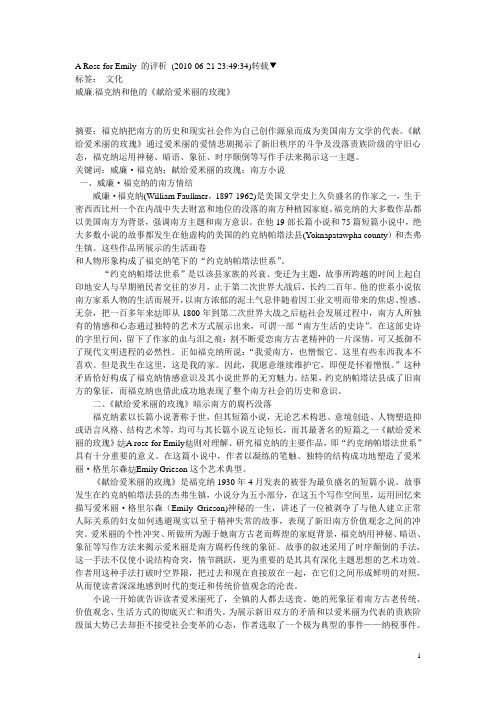
A Rose for Emily 的评析(2010-06-21 23:49:34)转载▼标签:文化威廉.福克纳和他的《献给爱米丽的玫瑰》摘要:福克纳把南方的历史和现实社会作为自己创作源泉而成为美国南方文学的代表。
《献给爱米丽的玫瑰》通过爱米丽的爱情悲剧揭示了新旧秩序的斗争及没落贵族阶级的守旧心态,福克纳运用神秘、暗语、象征、时序颠倒等写作手法来揭示这一主题。
关键词:威廉·福克纳;献给爱米丽的玫瑰;南方小说一、威廉·福克纳的南方情结威廉·福克纳(William Faulkner,1897-1962)是美国文学史上久负盛名的作家之一,生于密西西比州一个在内战中失去财富和地位的没落的南方种植园家庭。
福克纳的大多数作品都以美国南方为背景,强调南方主题和南方意识。
在他19部长篇小说和75篇短篇小说中,绝大多数小说的故事都发生在他虚构的美国的约克纳帕塔法县(Yoknapatawpha county)和杰弗生镇。
这些作品所展示的生活画卷和人物形象构成了福克纳笔下的“约克纳帕塔法世系”。
“约克纳帕塔法世系”是以该县家族的兴衰、变迁为主题,故事所跨越的时间上起自印地安人与早期殖民者交往的岁月,止于第二次世界大战后,长约二百年。
他的世系小说依南方家系人物的生活而展开,以南方浓郁的泥土气息伴随着因工业文明而带来的焦虑、惶惑、无奈,把一百多年来即从1800年到第二次世界大战之后社会发展过程中,南方人所独有的情感和心态通过独特的艺术方式展示出来,可谓一部“南方生活的史诗”。
在这部史诗的字里行间,留下了作家的血与泪之痕:割不断爱恋南方古老精神的一片深情,可又抵御不了现代文明进程的必然性。
正如福克纳所说:“我爱南方,也憎恨它。
这里有些东西我本不喜欢。
但是我生在这里,这是我的家。
因此,我愿意继续维护它,即便是怀着憎恨。
”这种矛盾恰好构成了福克纳情感意识及其小说世界的无穷魅力。
结果,约克纳帕塔法县成了旧南方的象征,而福克纳也借此成功地表现了整个南方社会的历史和意识。
A Rose For Emily(献给艾米丽的玫瑰花)
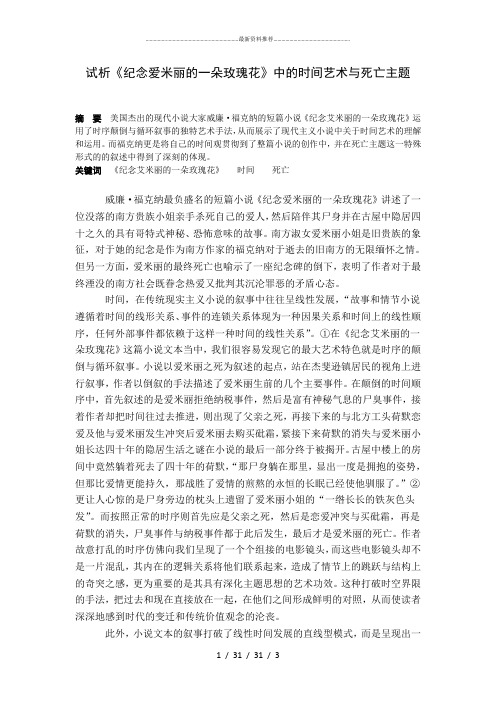
试析《纪念爱米丽的一朵玫瑰花》中的时间艺术与死亡主题摘要美国杰出的现代小说大家威廉·福克纳的短篇小说《纪念艾米丽的一朵玫瑰花》运用了时序颠倒与循环叙事的独特艺术手法,从而展示了现代主义小说中关于时间艺术的理解和运用。
而福克纳更是将自己的时间观贯彻到了整篇小说的创作中,并在死亡主题这一特殊形式的的叙述中得到了深刻的体现。
关键词《纪念艾米丽的一朵玫瑰花》时间死亡威廉·福克纳最负盛名的短篇小说《纪念爱米丽的一朵玫瑰花》讲述了一位没落的南方贵族小姐亲手杀死自己的爱人,然后陪伴其尸身并在古屋中隐居四十之久的具有哥特式神秘、恐怖意味的故事。
南方淑女爱米丽小姐是旧贵族的象征,对于她的纪念是作为南方作家的福克纳对于逝去的旧南方的无限缅怀之情。
但另一方面,爱米丽的最终死亡也喻示了一座纪念碑的倒下,表明了作者对于最终湮没的南方社会既眷念热爱又批判其沉沦罪恶的矛盾心态。
时间,在传统现实主义小说的叙事中往往呈线性发展,“故事和情节小说遵循着时间的线形关系、事件的连锁关系体现为一种因果关系和时间上的线性顺序,任何外部事件都依赖于这样一种时间的线性关系”。
①在《纪念艾米丽的一朵玫瑰花》这篇小说文本当中,我们很容易发现它的最大艺术特色就是时序的颠倒与循环叙事。
小说以爱米丽之死为叙述的起点,站在杰斐逊镇居民的视角上进行叙事,作者以倒叙的手法描述了爱米丽生前的几个主要事件。
在颠倒的时间顺序中,首先叙述的是爱米丽拒绝纳税事件,然后是富有神秘气息的尸臭事件,接着作者却把时间往过去推进,则出现了父亲之死,再接下来的与北方工头荷默恋爱及他与爱米丽发生冲突后爱米丽去购买砒霜,紧接下来荷默的消失与爱米丽小姐长达四十年的隐居生活之谜在小说的最后一部分终于被揭开。
古屋中楼上的房间中竟然躺着死去了四十年的荷默,“那尸身躺在那里,显出一度是拥抱的姿势,但那比爱情更能持久,那战胜了爱情的煎熬的永恒的长眠已经使他驯服了。
”②更让人心惊的是尸身旁边的枕头上遗留了爱米丽小姐的“一绺长长的铁灰色头发”。
a rose for emily解读与译赏

a rose for emily解读与译赏《A Rose for Emily》是美国作家威廉·福克纳的短篇小说,被认为是福克纳最杰出的作品之一。
这个故事揭示了一位孤独的南方女性艾米丽·格里森的生活,以及她与社会的冲突和疏离感。
故事以艾米丽的葬礼开始,随后回溯到她生前的往事。
艾米丽是一个古怪而孤立的人物,她居住在一个受到时间遗忘的南方小镇,被当地人视为传奇。
她的父亲在她年轻的时候过世,使得她变得孤独和隐居。
她与一个北方建筑师霍默·巴伦的关系引起了镇上人的不满和猜疑,但他们之间的真实情况始终是个谜。
艾米丽的生活充满了秘密和谜团,她甚至杀害了她的恋人霍默并将他的尸体保存在一个密封的房间中。
这种行为揭示了她的精神崩溃和对时间的无法接受。
她试图保存过去的美好时光,但却无法逃脱时间的流逝。
作者通过描写艾米丽的故事,深入探讨了社会和传统观念对个体的压迫和破坏。
这个故事中的玫瑰象征着美好的过去和爱情。
艾米丽失去了父亲和她的恋人,她试图保留他们的存在并抵抗时间的消逝。
她在封闭的世界里过着与现实隔绝的生活,就像一个被遗忘的花朵。
然而,随着时间的推移,玫瑰凋谢了,就像艾米丽最终被时间所击败。
《A Rose for Emily》是福克纳对南方社会的批判,揭示了社会对个人的限制和破坏力量。
艾米丽代表着被压迫和被孤立的个体,她的悲剧反映了整个社会体系的腐败和堕落。
通过描写艾米丽的故事,福克纳呈现了一个关于时间、孤独和爱的复杂而深刻的图景。
总之,《A Rose for Emily》是一部充满象征主义和深度的文学作品,通过描述一个女性的孤独和精神崩溃,揭示了社会对个体的压迫和摧毁。
福克纳通过这个故事,向读者展示了一个关于时间、爱和社会的不公的悲剧。
ARoseforEmily书评
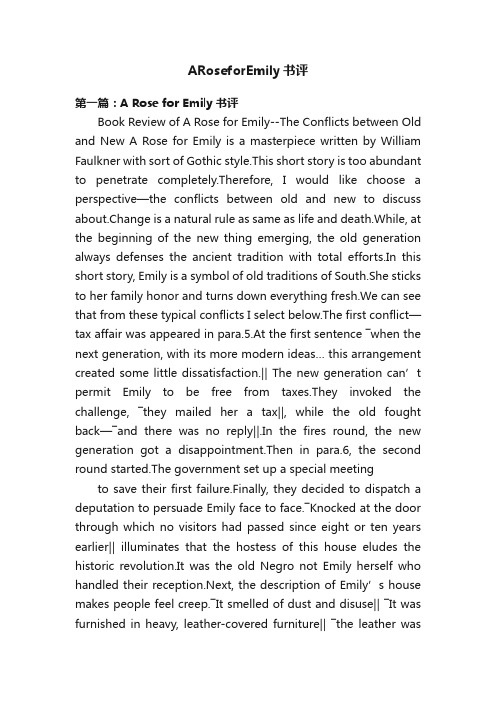
ARoseforEmily书评第一篇:A Rose for Emily书评Book Review of A Rose for Emily--The Conflicts between Old and New A Rose for Emily is a masterpiece written by William Faulkner with sort of Gothic style.This short story is too abundant to penetrate completely.Therefore, I would like choose a perspective—the conflicts between old and new to discuss about.Change is a natural rule as same as life and death.While, at the beginning of the new thing emerging, the old generation always defenses the ancient tradition with total efforts.In this short story, Emily is a symbol of old traditions of South.She sticks to her family honor and turns down everything fresh.We can see that from these typical conflicts I select below.The first conflict—tax affair was appeared in para.5.At the first sentence ―when the next generation, with its more modern ideas… this arrangement created some little dissatisfaction.‖ The new generation can’t permit Emily to be free from taxes.They invoked the challenge, ―they mailed her a tax‖, while the old fought back—―and there was no reply‖.In the fires round, the new generation got a disappointment.Then in para.6, the second round started.The government set up a special meeting to save their first failure.Finally, they decided to dispatch a deputation to persuade Emily face to face.―Knocked at the door through which no visitors had passed since eight or ten years earlier‖ illuminates that the hostess of this house eludes the historic revolution.It was the old Negro not Emily herself who handled their reception.Next, the description of Emily’s house makes people feel creep.―It smelled of dust and disuse‖ ―It was furnished in heavy, leather-covered furniture‖ ―the leather wascracked‖ etc.Especially, a profound ―stood‖ in the last sentence when picturing the crayon portrait of Emily’s father illustrates that the old thoughts were still alive.Para.7 has the first appearance of Emily.―They rose when she entered.‖ They ―rose‖ may be out of their respect to the old cultural Emily stood for, or may be because they were surprised by Emily’s appearance.―a small, fat woman in black‖ ―a thin gold chain descending to her waist and vanishing into her belt‖ shows that she hated changing.―She looke d bloated, like a body long submerged in motionless water‖ This magical sketch makes people’s hair stand on the end.The old thoughts were degrading but the old warrior didn’t vanish.Para.8 exposes Emily’s distasteful attitude towards new thoughts.―She did not ask them to sit.‖ The ―just‖ explains the absolute arrogance ofEmily, it causes that ―the spokesman came to a stumbling halt‖.Although the conflict hadn’t started yet, Emily occupied the superiority.Para9—15 is a fierce argument between Emily and depu tation.―Her voice was dry and cold‖.The repetition of ―I have no taxes in Jefferson‖ accounts for the ―dry‖ and ―I received a paper, yes‖ ―Perhaps he considers himself the sheriff‖ and ―See Colonel Sartoris‖ ―Show these gentlemen out‖ demonstrates the ―cold‖.―dry‖ and ―cold‖ also mean that she despises newfangled stuffs.Para.16 is a transition.In first conflict, ―she vanquished them, horse and foot‖, then it naturally leads into the second conflict ―she had vanquished their fathers thirty years before and the smell.Chronologically, the second conflict happened earlier than the first.Para.17 gives the background of ―the smell‖ affair –―her father’s death‖ ―her sweetheart went away.‖ These two disasters create suspense to readers.What’s the relationship betwee n them and ―the smell‖?Para.18—22, the author drug out ―the smell‖ affair from women’s complaints.―the mayor‖ who was ―eighty years old‖ expressed his incapability—―what will you have me do about it?‖ The mayor is also aprotector of old generation.Therefore, he made a negative decision on handling ―the smell‖ problem.Para23—25, town people showed their dissatisfaction again.―One from a man who came in different deprecation‖ narrates his fear towards the judge.―One younger man, a member of the rising generation‖ made a more powerful utterance.Obviously, Judge Stevens disliked ―the younger man’s‖ bold tone, so he said ―Dammit, sir‖ to disapproved of him.Para.26 says how the town people solved the ―smell‖ problem.Without the endorsement from government, four men determined to handle this difficulty by themselves.From the view of a long distance away, they were ―like burglars‖ ―sniffing along the base of the brickwork‖ ―one of them performed a regular sowing motion.‖ Until now, readers might understand what they doing were.Suddenly, the author cuts shot closer.―a window that had been dark was delighted and Miss Emily sat in it…her upright torso motionless as that of an idol.‖ This portrait of Emily truly scares me.She saw the invasion of someone else, perhaps she has already collapsed mentally, and hence she did nothing but sat like a stone.In this conflict, the new generation won.After all, ―after a week or two the smell went away‖.Besides the occurrence I analyzed above, the love tragedy between Emily and Homer Barron also can be considered as the consequence of the conflict between North and South.In this novel, Emily symbolizes the South, old and tradition, the Yankee represents the North, new and modern.Both young guys might be interested in each other when they first meet.But they possessaltogether different values or concept of lives.So they inevitably separated before long.The conflict between the two partners symbolizes the conflict between the South and the North.And the absurd murder aggravates the contradictions.When I finished reading the story, a sincere sympathy emerges in my mind.Emily is totally a tragedy of the old traditions.She is a prisoner of the past, of the social and moral taboos of the South.In our daily life, everything is changing everyday.As an individual, we can only adapt ourselves to the protean environment and should learn to accept new things.In the war of ―new against old‖, the former always is the winner by the test of history.第二篇:书评书评范文(一)——《菜根谭》书评一个非常非常平凡的人,写了一部让历史永远不能忘却的奇书,那就是《菜根谭》。
A Rose for Emily翻译研究
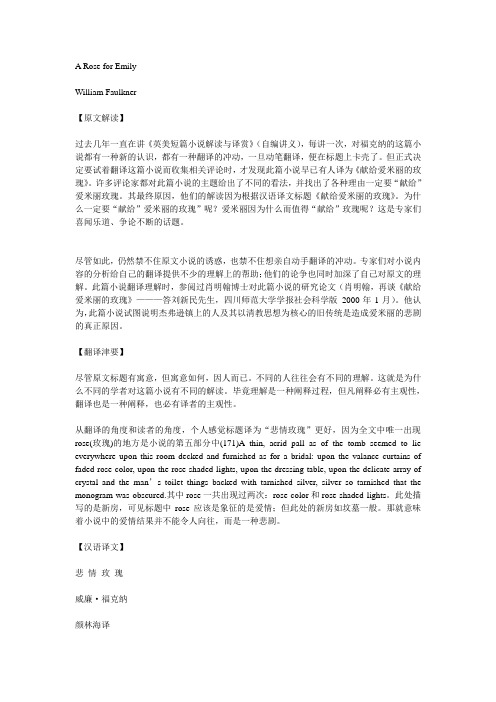
A Rose for EmilyWilliam Faulkner【原文解读】过去几年一直在讲《英美短篇小说解读与译赏》(自编讲义),每讲一次,对福克纳的这篇小说都有一种新的认识,都有一种翻译的冲动,一旦动笔翻译,便在标题上卡壳了。
但正式决定要试着翻译这篇小说而收集相关评论时,才发现此篇小说早已有人译为《献给爱米丽的玫瑰》。
许多评论家都对此篇小说的主题给出了不同的看法,并找出了各种理由一定要“献给”爱米丽玫瑰。
其最终原因,他们的解读因为根据汉语译文标题《献给爱米丽的玫瑰》。
为什么一定要“献给”爱米丽的玫瑰”呢?爱米丽因为什么而值得“献给”玫瑰呢?这是专家们喜闻乐道、争论不断的话题。
尽管如此,仍然禁不住原文小说的诱惑,也禁不住想亲自动手翻译的冲动。
专家们对小说内容的分析给自己的翻译提供不少的理解上的帮助;他们的论争也同时加深了自己对原文的理解。
此篇小说翻译理解时,参阅过肖明翰博士对此篇小说的研究论文(肖明翰,再谈《献给爱米丽的玫瑰》———答刘新民先生,四川师范大学学报社会科学版2000年1月)。
他认为,此篇小说试图说明杰弗逊镇上的人及其以清教思想为核心的旧传统是造成爱米丽的悲剧的真正原因。
【翻译津要】尽管原文标题有寓意,但寓意如何,因人而已。
不同的人往往会有不同的理解。
这就是为什么不同的学者对这篇小说有不同的解读。
毕竟理解是一种阐释过程,但凡阐释必有主观性,翻译也是一种阐释,也必有译者的主观性。
从翻译的角度和读者的角度,个人感觉标题译为“悲情玫瑰”更好,因为全文中唯一出现rose(玫瑰)的地方是小说的第五部分中(171)A thin, acrid pall as of the tomb seemed to lie everywhere upon this room decked and furnished as for a bridal: upon the valance curtains of faded rose color, upon the rose-shaded lights, upon the dressing table, upon the delicate array of crystal and the man’s toilet things backed with tarnished silver, silver so tarnished that the monogram was obscured.其中rose一共出现过两次:rose color和rose-shaded lights。
ARoseforEmily主题分析
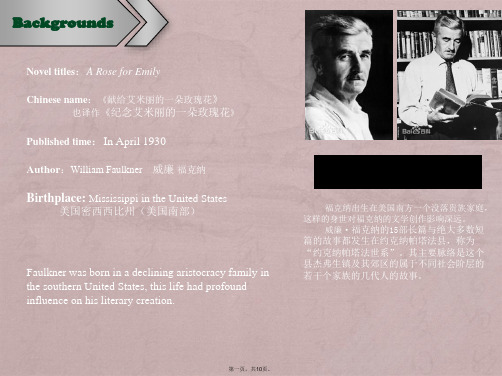
Faulkner was born in a declining aristocracy family in the southern United States, this life had profound influence on his literary creation.
第二页,共10页。
Backgrounds
A Rose for Emily represents Faulkner‘s greatest achievements in the writing of short stories. Modernist writing techniques are skillfully used by Faulkner to tell the tragic life of Emily to show the incompatible inner spiritual world of American South in a specific period which is aimed at exploring the eternal theme of conflicts
南方传统的价值观念与文明现代化之间的矛盾
Emily
南方社会道德和父权制的束缚和压迫 男权至上(父亲 兄长 丈夫) 清教思想
Miss Emily a slender figure in white in the background, her father a spraddled silhouette in the foreground, his back to her and clutching a horsewhip, the two of them framed by the back-flung front door.
a rose for Emily 分析

A Rose for Emily 的评析(2010-06-21 23:49:34)转载▼标签:文化威廉.福克纳和他的《献给爱米丽的玫瑰》摘要:福克纳把南方的历史和现实社会作为自己创作源泉而成为美国南方文学的代表。
《献给爱米丽的玫瑰》通过爱米丽的爱情悲剧揭示了新旧秩序的斗争及没落贵族阶级的守旧心态,福克纳运用神秘、暗语、象征、时序颠倒等写作手法来揭示这一主题。
关键词:威廉·福克纳;献给爱米丽的玫瑰;南方小说一、威廉·福克纳的南方情结威廉·福克纳(William Faulkner,1897-1962)是美国文学史上久负盛名的作家之一,生于密西西比州一个在内战中失去财富和地位的没落的南方种植园家庭。
福克纳的大多数作品都以美国南方为背景,强调南方主题和南方意识。
在他19部长篇小说和75篇短篇小说中,绝大多数小说的故事都发生在他虚构的美国的约克纳帕塔法县(Yoknapatawpha county)和杰弗生镇。
这些作品所展示的生活画卷和人物形象构成了福克纳笔下的“约克纳帕塔法世系”。
“约克纳帕塔法世系”是以该县家族的兴衰、变迁为主题,故事所跨越的时间上起自印地安人与早期殖民者交往的岁月,止于第二次世界大战后,长约二百年。
他的世系小说依南方家系人物的生活而展开,以南方浓郁的泥土气息伴随着因工业文明而带来的焦虑、惶惑、无奈,把一百多年来即从1800年到第二次世界大战之后社会发展过程中,南方人所独有的情感和心态通过独特的艺术方式展示出来,可谓一部“南方生活的史诗”。
在这部史诗的字里行间,留下了作家的血与泪之痕:割不断爱恋南方古老精神的一片深情,可又抵御不了现代文明进程的必然性。
正如福克纳所说:“我爱南方,也憎恨它。
这里有些东西我本不喜欢。
但是我生在这里,这是我的家。
因此,我愿意继续维护它,即便是怀着憎恨。
”这种矛盾恰好构成了福克纳情感意识及其小说世界的无穷魅力。
结果,约克纳帕塔法县成了旧南方的象征,而福克纳也借此成功地表现了整个南方社会的历史和意识。
A rose for Emily 分析(人物,象征,背景)
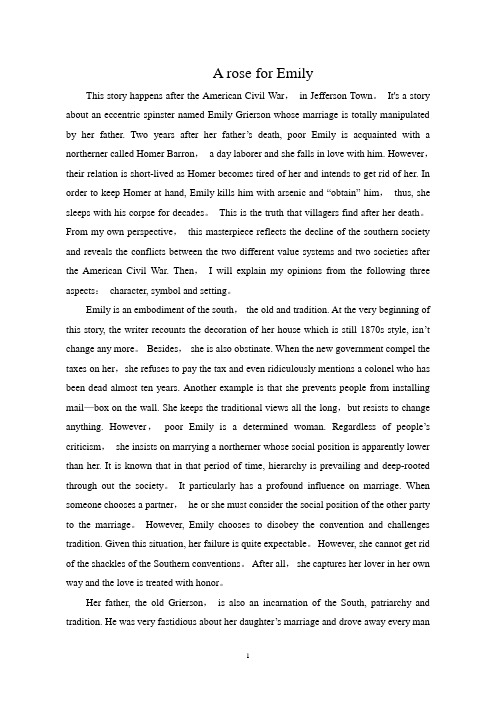
A rose for EmilyThis story happens after the American Civil War,in Jefferson Town。
It's a story about an eccentric spinster named Emily Grierson whose marriage is totally manipulated by her father. Two years after her father’s death, poor Emily is acquainted with a northerner called Homer Barron,a day laborer and she falls in love with him. However,their relation is short-lived as Homer becomes tired of her and intends to get rid of her. In order to keep Homer at hand, Emily kills him with arsenic and “obtain” him,thus, she sleeps with his corpse for decades。
This is the truth that villagers find after her death。
From my own perspective,this masterpiece reflects the decline of the southern society and reveals the conflicts between the two different value systems and two societies after the American Civil War. Then,I will explain my opinions from the following three aspects:character, symbol and setting。
A_rose_for_Emily_分析(人物_象征_背景)

A rose for EmilyThis story happens after the American Civil War, in Jefferson Town. It’s a story about an eccentric spinster named Emily Grierson whose marriage is totally manipulated by her father. Two years after her father’s death, poor Emily is acquainted with a northerner called Homer Barron, a day laborer and she falls in love with him. However, their relation is short-lived as Homer becomes tired of her and intends to get rid of her. In order to keep Homer at hand, Emily kills him with arsenic and “obtain”him, thus, she sleeps with his corpse for decades. This is the truth that villagers find after her death. From my own perspective, this masterpiece reflects the decline of the southern society and reveals the conflicts between the two different value systems and two societies after the American Civil War. Then, I will explain my opinions from the following three aspects: character, symbol and setting.Emily is an embodiment of the south, the old and tradition. At the very beginning of this story, the writer recounts the decoration of her house which is still 1870s style, isn’t change any more. Besides, she is also obstinate. When the new government compel the taxes on her,she refuses to pay the tax and even ridiculously mentions a colonel who has been dead almost ten years. Another example is that she prevents people from installing mail-box on the wall. She keeps the traditional views all the long,but resists to change anything. However, poor Emily is a determined woman. Regardless of people’s criticism, she insists on marrying a northerner whose social position is apparently lower than her. It is known that in that period of time, hierarchy is prevailing and deep-rooted through out the society. It particularly has a profound influence on marriage. When someone chooses a partner, he or she must consider the social position of the other party to the marriage. However, Emily chooses to disobey the convention and challenges tradition. Given this situation, her failure is quite expectable. However, she cannot get rid of the shackles of the Southern conventions. After all, she captures her lover in her own way and the love is treated with honor.Her father, the old Grierson, is also an incarnation of the South, patriarchy and tradition. He was very fastidious about her daughter’s marriage and drove away every manwho caught the fancy of her. “When she got to thirty and was still single”. Obviously, both her body and mind are enslaved by her father’s traditional concept. Therefore, she feels released when her father is dead, and there is no “trace of grief on her face”.In this novel, Emily symbolizes the South, old and tradition, the Y ankee represents the North, new and modern. Both young guys might be interested in each other when they first meet. But they possess altogether different values or concept of lives. So they inevitably separated before long. The conflict between the two partners symbolizes the conflict between the South and the North. And the absurd murder aggravates the contradictions.The “Rose”, that is never mentioned in this novel, is always interpreted conventionally as a symbol of love. It might be used as the love Emily gets from her lover. But in my opinion the rose mainly represents decay and death. At the time the villagers went to her room and found the valance curtains of faded rose color and the rose-shaded lights in the room. Actually, the author plays a trick on Miss Emily. In fact, she doesn’t really get any love from any man whether it is from her lover or her father. Emily could have a favorable marriage but for her father’s interference. She could have got her deserved love from Homer. But on account of her obstinacy and pride, she receives tiredness and indifference, instead of affection---rose, from him. Thus, as an outsider, the author or the villagers, they give a rose as a tribute to Emily. Besides, the rose also stands for the author’s and villager s’pity, sympathy and lament for Emily, whose mind is imprisoned in the past and fails to adapt to the change. What’s more, the author, “William Faulkner objectifies his complicated and emotional involvement in the South and in the people who grow up and live there ever since”.The story teller begins his story when it is post-civil war. In Jefferson Town, in the South, which is defeated by the North, everything including concept and some sense of value is gradually replaced by the new concepts from the North. In this background, due to the restriction of the traditional ideas, some people are imprisoned in the past and ignore the passage of time. And Miss Emily is one of them. The whole story is set in Emily’s house. But the story has a time span of over two scores. Her house is depicted as old but grand. Seen from the outside, the house is really outdated and is not in accordwith other residential buildings—it’s really an eyesore. The house perfectly mirrors Emily’s isolation from the outside world. From the inner decoration of her house, everything is covered with dust and the air is humid. Besides,there is a crayon portrait of Miss Emily’s father. The description of the house paves a way for the development of scenario. As a reader, I might feel ghastly. Therefore, it’s conceivable that the spine-chilling story happens there. At the end of the story, out of curiosity, people go into her chamber,seeing faded rose color curtains, the rose-shaded lights and delicate array of crystal and the man's toilet things backed with tarnished silver. The whole room speaks the life Emily goes through and indicates the decay of the Southern aristocrat.When I finished reading the story, a sincere sympathy emerges in my mind. Emily is totally a tragedy of the old traditions. She is a prisoner of the past, of the social and moral taboos of the South. Not only because she is purely a woman, but also the stubborn conventions manacle her that result in her frustrated life. Even so,she could have a better life after her father’s death. However, she doesn’t get out of the tower her father built for her. On the contrary, she builds another one, and locks her soul. In our daily life, everything is changing everyday. As an individual, we can only adapt ourselves to the protean environment and should learn to accept new things. Only when we keep learning everyday can we survive in this world which is full of competition.“A Rose for Emily” is divided into five sections.The first section opens with a description of the Grierson house in Jefferson. The narrator mentions that over the past 100 years, Miss Emily Grierson’s home has fall into disrepair and become “an eyesore among eyesores.” The first sentence of the story sets the ton e of how the citizens of Jefferson felt about Emily: “When Miss Emily Grierson died, our whole town went to the funeral: the men through a sort of respectful affection for a fallen monument, the women mostly out of curiosity to see the inside of her house, which no one save an old manservant – a combined gardener and cook –had seen in at least ten years.”It is known around town that Emily Grierson has not had guests in her home for the past decade, except her black servant who runs errands for her to and from the market. When a new city council takes over, however, they begin to tax her once again. She refuses to pay the taxes and appear before the sheriff, so the city authorities invite themselves into her house. When confronted on her tax evasion, Emily reminds them that she doesn't have to pay taxes in Jefferson and to speak to Colonel Sartoris, although he had died 10 years before.In section two, the narrator explains that the Griersons had always been a very proud Southern family. Mr. Grierson, Em ily’s father, believes no man is suitable for his daughter and doesn't allow her to date. Emily is largely dependent upon her father, and is left foundering when he dies. After Mr. Grierson's death, Emily does not allow the authorities to remove his body f or three days, claiming he is still alive. She breaks down and allows authorities to take the body away for a quick burial.Section three introduces Emily’s beau, Homer Barron, a foreman from the north. Homer comes to Jefferson with a crew of men to build sidewalks outside the Grierson home. After Emily and Homer are seen driving through town several times, Emily visits a druggist. There, she asks to purchase arsenic. The druggist asks what the arsenic is for since it was required of him to ask by law. Emily does not respond and coldly stares him down until he looks away and gives her the arsenic. When Emily opens the package, underneath the skull and bones sign is written, "For Rats."Citizens of Jefferson believe that Miss Emily is going to commit suicide since Homer has not yet proposed in the beginning of section four. The townspeople contact and invite Emily's two cousins to comfort her. Shortly after their arrival, Homer leaves and then returns after the cousins leave Jefferson. After staying in Jefferson for one night, Homer is never seen again. After Homer’s disappearance, Emily begins to age, gain weight, and is rarely seen outside of her home. Soon, Miss Emily passes away.The fifth and final section begins with Jefferson women entering the Grierson home. After they arrive, Emily's black servant leaves through the back door without saying a word. After Emily's funeral, the townspeople immediately go through her house. They come across a room on the second floor which no one had seen in 40 years, and break the door down. They discover a dusty room strangely decorated as a bridal room. The room contains a man's tie, suit and shoes, and a silver toilet set which Miss Emily had purchased for Homer years before his disappearance. Homer's remains lay on the bed, dressed in a nightshirt. Next to him is an impression of a head on a pillow where the townspeople find a single “long strand of iron-gray hair.” It is thus implied that not only had Emily killed Homer with the arsenic, but also has had an intimate relationship with his corpse up to her own death.简评:Miss Emily met Homer Baron, a foreman with a construction company, when her hometown was first getting paved streets. Her father had already died but, not before driving away her eligible suitors. As rumors circulate about her possible marriage to a Yankee, Homer leaves town abruptly. During his absence, Miss Emily buys rat poison.When Homer returns, the townspeople see him enter Miss Emily’s house but not leave. Only when she dies do the townspeople discover his corpse on a bed in her house and, next to it, a strand of Miss Emily’s hair.This Gothic plot makes serious points about woman’s place in society. Throughout the story, the reader is aware that these events are taking place during a time of transition: The town is finally getting sidewalks and mailboxes. More important, values are changing. The older magistrates, for example, looked on Miss Emily paternally and refused to collect taxes from her; the newer ones try, unsuccessfully, to do so.Caught in these changing times, Miss Emily is trapped in her role as genteel spinster. Without a husband, her life will have no meaning. She tries to give lessons in painting china but cannot find pupils for this out-of-date hobby and finally discontinues them. If Homer is thinking of abandoning her, as his departure implies, one can understand her desire to clutch at any sort of union, even a marriage in death.The theme is developed through an exceptionally well-crafted story. Told from a third-person plural point of view, it reveals the reactions of the town to Miss Emily. As this “we” narrator shifts allegiance--now criticizing Miss Emily, now sympathizing with her--the reader sees the trap in which she is caught, and the extensive but unobtrusive foreshadowing prepares the reader for the story’s final r evelation without detracting from its force.。
MyReviewofARoseforEmily,献给艾米丽的玫瑰英文读后感

MyReviewofARoseforEmily,献给艾⽶丽的玫瑰英⽂读后感My Review of “A Rose for Emily”--By Cave dweller William Faulkner's "A Rose for Emily" is a short story which mainly describes a faded southern aristocrat, Emily Grierson's tragic life. An unnamed narrator vividly tells six impressive anecdotes to present Emily's life with an intelligent use of flashbacks. But after reading the story, we can divide it into six parts according the chronological order.The first part is the death of Emily's father. When her father died, the house is all that is left to her. This part reveals that to a certain extent, her father who has driven away all the young men should be responsible for her tragedy.The second part is Emily's miserable relationship. She falls in love with a foreman named Homer Barron, a dark, ready man, who has no interest in marriage. Then people are told that the man deserts her.The third is "the smell". After her father's death and heart-broken love, she only has a manservant. So her house smells bad. The people in town complain about it. In the end, they solve it by sprinkling lime around her house.The fourth part is Emily's teaching life. She gives lessons in china-painting several years and then closes her front forever.The fifth is the confrontation between Emily and the deputation. The young generation is dissatisfied with the edict of remitting her taxes. They send a deputation to negotiate this problem. But they failed. She vanquished them.The sixth part is Emily's funeral and the discovery of the dead man in her house. After the funeral, people decide to open the room which no one has seen in forty years. Then, they find a dead man in bed.The setting of the story is the declining of the southern aristocrats in America.The novel has been regarded as a Gothic horror tale, a study in abnormal psychology as well as an allegory of the relations between North and South. The novel's name is "A Rose for Emily", it tells little about rose, but much about the tragic heroine, Emily. Therefore,the rose represents Emily, which actually is an elegy sighting the lost prosperity of the South aristocracy. So the memory of the South aristocrats' glory is prominent in southern people's minds, which causes various conflicts and contractions in their psyche. Apparently, Emily is one of these people who think all the past is not a diminishing road but a huge meadow. Emily does not in her time but in the lost glory of South aristocracy. Her eccentric and wired behaviors are the surface of her psychological world which fills with conflicts and complexity. Her own unhealthy psychological world can be considered as a cause of her tragic life. The incorrect family education has caused her tragedy. Her father's archaic thoughts have passive influence on her life. Her father drives away all the young men. Her father interferes in her life too much.。
aroseforemily故事主要内容
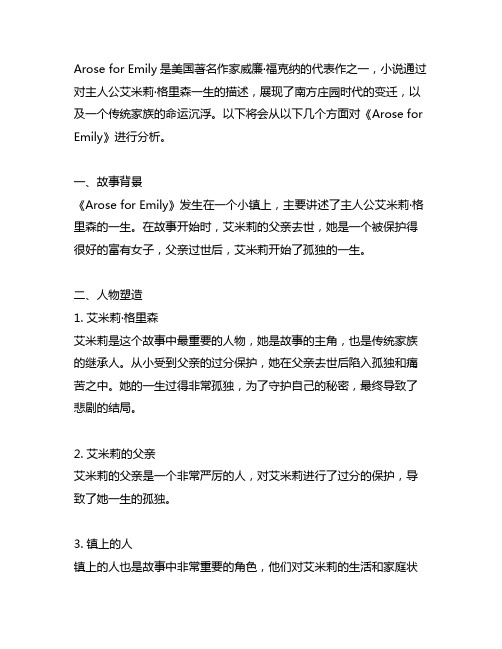
Arose for Emily是美国著名作家威廉·福克纳的代表作之一,小说通过对主人公艾米莉·格里森一生的描述,展现了南方庄园时代的变迁,以及一个传统家族的命运沉浮。
以下将会从以下几个方面对《Arose for Emily》进行分析。
一、故事背景《Arose for Emily》发生在一个小镇上,主要讲述了主人公艾米莉·格里森的一生。
在故事开始时,艾米莉的父亲去世,她是一个被保护得很好的富有女子,父亲过世后,艾米莉开始了孤独的一生。
二、人物塑造1. 艾米莉·格里森艾米莉是这个故事中最重要的人物,她是故事的主角,也是传统家族的继承人。
从小受到父亲的过分保护,她在父亲去世后陷入孤独和痛苦之中。
她的一生过得非常孤独,为了守护自己的秘密,最终导致了悲剧的结局。
2. 艾米莉的父亲艾米莉的父亲是一个非常严厉的人,对艾米莉进行了过分的保护,导致了她一生的孤独。
3. 镇上的人镇上的人也是故事中非常重要的角色,他们对艾米莉的生活和家庭状况非常好奇,也对她充满了好奇和怀疑。
三、主题1. 传统与现代故事中对传统与现代的冲突是一个非常重要的主题。
艾米莉所处的年代正是南方庄园时代向现代过渡的时期,她在这个转变的时代里,陷入了传统与现代的矛盾之中。
2. 父女关系故事中父女关系也是一个重要的主题。
艾米莉在父亲去世后,陷入了孤独和痛苦之中,她在父亲去世后的一生也受到了父亲影响。
四、故事结局故事的结局是悲剧性的,艾米莉在孤独和痛苦中渐渐走向了精神崩溃,最终导致了一场悲剧。
这个结局也体现了《Arose for Emily》中对人性的沉思和对传统的思考。
通过以上分析,可以看出《Arose for Emily》是一部非常重要的文学作品,它展现了作者威廉·福克纳对美国南方庄园时代的深刻思考,也对传统与现代、父女关系等主题进行了深入的探讨。
这部小说不仅在文学价值上有着极高的地位,也在思想性和艺术性上都是非常出色的。
a-rose-for-Emily-分析

A Rose for Emily 的评析(2010-06-21 23:49:34)转载▼标签:文化威廉.福克纳和他的《献给爱米丽的玫瑰》摘要:福克纳把南方的历史和现实社会作为自己创作源泉而成为美国南方文学的代表。
《献给爱米丽的玫瑰》通过爱米丽的爱情悲剧揭示了新旧秩序的斗争及没落贵族阶级的守旧心态,福克纳运用神秘、暗语、象征、时序颠倒等写作手法来揭示这一主题。
关键词:威廉·福克纳;献给爱米丽的玫瑰;南方小说一、威廉·福克纳的南方情结威廉·福克纳(William Faulkner,1897-1962)是美国文学史上久负盛名的作家之一,生于密西西比州一个在内战中失去财富和地位的没落的南方种植园家庭。
福克纳的大多数作品都以美国南方为背景,强调南方主题和南方意识。
在他19部长篇小说和75篇短篇小说中,绝大多数小说的故事都发生在他虚构的美国的约克纳帕塔法县(Yoknapatawpha county)和杰弗生镇。
这些作品所展示的生活画卷和人物形象构成了福克纳笔下的“约克纳帕塔法世系”。
“约克纳帕塔法世系”是以该县家族的兴衰、变迁为主题,故事所跨越的时间上起自印地安人与早期殖民者交往的岁月,止于第二次世界大战后,长约二百年。
他的世系小说依南方家系人物的生活而展开,以南方浓郁的泥土气息伴随着因工业文明而带来的焦虑、惶惑、无奈,把一百多年来即从1800年到第二次世界大战之后社会发展过程中,南方人所独有的情感和心态通过独特的艺术方式展示出来,可谓一部“南方生活的史诗”。
在这部史诗的字里行间,留下了作家的血与泪之痕:割不断爱恋南方古老精神的一片深情,可又抵御不了现代文明进程的必然性。
正如福克纳所说:“我爱南方,也憎恨它。
这里有些东西我本不喜欢。
但是我生在这里,这是我的家。
因此,我愿意继续维护它,即便是怀着憎恨。
”这种矛盾恰好构成了福克纳情感意识及其小说世界的无穷魅力。
结果,约克纳帕塔法县成了旧南方的象征,而福克纳也借此成功地表现了整个南方社会的历史和意识。
A_rose_for_Emily分析
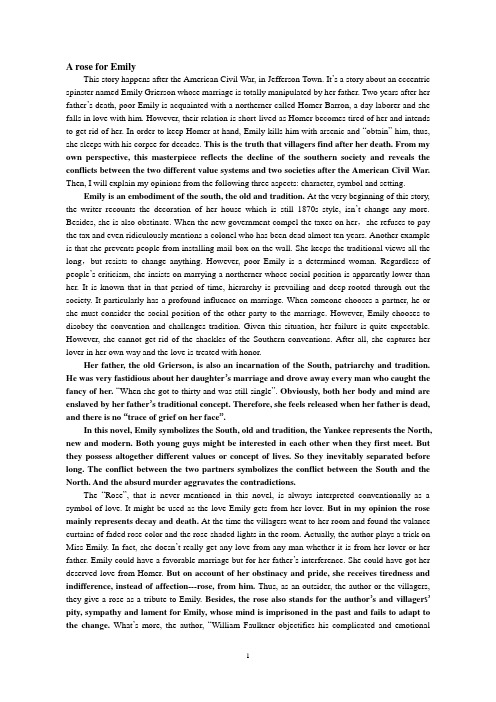
A rose for EmilyThis story happens after the American Civil War, in Jefferson Town. It’s a story about an eccentric spinster named Emily Grierson whose marriage is totally manipulated by her father. Two years after her father’s death, poor Emily is acquainted with a northerner called Homer Barron, a day laborer and she falls in love with him. However, their relation is short-lived as Homer becomes tired of her and intends to get rid of her. In order to keep Homer at hand, Emily kills him with arsenic and “obtain” him, thus, she sleeps with his corpse for decades. This is the truth that villagers find after her death. From my own perspective, this masterpiece reflects the decline of the southern society and reveals the conflicts between the two different value systems and two societies after the American Civil War. Then, I will explain my opinions from the following three aspects: character, symbol and setting.Emily is an embodiment of the south, the old and tradition. At the very beginning of this story, the writer recounts the decoration of her house which is still 1870s style, isn’t change any more. Besides, she is also obstinate. When the new government compel the taxes on her,she refuses to pay the tax and even ridiculously mentions a colonel who has been dead almost ten years. Another example is that she prevents people from installing mail-box on the wall. She keeps the traditional views all the long,but resists to change anything. However, poor Emily is a determined woman. Regardless of people’s criticism, she insists on marrying a northerner whose social position is apparently lower than her. It is known that in that period of time, hierarchy is prevailing and deep-rooted through out the society. It particularly has a profound influence on marriage. When someone chooses a partner, he or she must consider the social position of the other party to the marriage. However, Emily chooses to disobey the convention and challenges tradition. Given this situation, her failure is quite expectable. However, she cannot get rid of the shackles of the Southern conventions. After all, she captures her lover in her own way and the love is treated with honor.Her father, the old Grierson, is also an incarnation of the South, patriarchy and tradition. He was very fastidious about her daughter’s marriage and drove away every man who caught the fancy of her. “When she got to thirty and was still single”. Obviously, both her body and mind are enslaved by her father’s traditional concept. Therefore, she feels released when her father is dead, and there is no “trace of grief on her face”.In this novel, Emily symbolizes the South, old and tradition, the Yankee represents the North, new and modern. Both young guys might be interested in each other when they first meet. But they possess altogether different values or concept of lives. So they inevitably separated before long. The conflict between the two partners symbolizes the conflict between the South and the North. And the absurd murder aggravates the contradictions.The “Rose”, that is never mentioned in this novel, is always interpreted conventionally as a symbol of love. It might be used as the love Emily gets from her lover. But in my opinion the rose mainly represents decay and death. At the time the villagers went to her room and found the valance curtains of faded rose color and the rose-shaded lights in the room. Actually, the author plays a trick on Miss Emily. In fact, she doesn’t really get any love from any man whether it is from her lover or her father. Emily could have a favorable marriage but for her father’s interference. She could have got her deserved love from Homer. But on account of her obstinacy and pride, she receives tiredness and indifference, instead of affection---rose, from him. Thus, as an outsider, the author or the villagers, they give a rose as a tribute to Emily. Besides, the rose also stands for the author’s and villager s’pity, sympathy and lament for Emily, whose mind is imprisoned in the past and fails to adapt to the change. What’s more, the author, “William Faulkner objectifies his complicated and emotionalinvolvement in the South and in the people who grow up and live there ever since”.The story teller begins his story when it is post-civil war. In Jefferson Town, in the South, which is defeated by the North, everything including concept and some sense of value is gradually replaced by the new concepts from the North. In this background, due to the restriction of the traditional ideas, some people are imprisoned in the past and ignore the passage of time. And Miss Emily is one of them. The whole story is set in Emily’s house. But the story has a time span of over two scores. Her house is depicted as old but grand. Seen from the outside, the house is really outdated and is not in accord with other residential buildings—it’s really an eyesore. The house perfectly mirrors Emily’s isolation from the outside world. From the inner decoration of her house, everything is covered with dust and the air is humid. Besides,there is a crayon portrait of Miss Emily’s father. The description of the house paves a way for the development of scenario. As a reader, I might feel ghastly. Therefore, it’s conceivable that the spine-chilling story happens there. At the end of the story, out of curiosity, people go into her chamber,seeing faded rose color curtains, the rose-shaded lights and delicate array of crystal and the man's toilet things backed with tarnished silver. The whole room speaks the life Emily goes through and indicates the decay of the Southern aristocrat.When I finished reading the story, a sincere sympathy emerges in my mind. Emily is totally a tragedy of the old traditions. She is a prisoner of the past, of the social and moral taboos of the South. Not only because she is purely a woman, but also the stubborn conventions manacle her that result in her frustrated life. Even so,she could have a better life after her father’s death. However, she doesn’t get out of the tower her father built for her. On the contrary, she builds another one, and locks her soul. In our daily life, everything is changing everyday. As an individual, we can only adapt ourselves to the protean environment and should learn to accept new things. Only when we keep learning everyday can we survive in this world which is full of competition.2.艾米丽是一个体现了南方,旧传统。
- 1、下载文档前请自行甄别文档内容的完整性,平台不提供额外的编辑、内容补充、找答案等附加服务。
- 2、"仅部分预览"的文档,不可在线预览部分如存在完整性等问题,可反馈申请退款(可完整预览的文档不适用该条件!)。
- 3、如文档侵犯您的权益,请联系客服反馈,我们会尽快为您处理(人工客服工作时间:9:00-18:30)。
“A Rose for Emily” is divided into five sections.The first section opens with a description of the Grierson house in Jefferson. The narrator mentions that over the past 100 years, Miss Emily Grierson’s home has fall into disrepair and become “an eyesore among eyesores.” The first sentence of the story sets the tone of how the citizens of Jefferson felt about Emily: “When Miss Emily Grierson died, our whole town went to the funeral: the men through a sort of respectful affection for a fallen monument, the women mostly out of curiosity to see the inside of her house, which no one save an old manservant – a combined gardener and cook – had seen in at least ten years.”It is known around town that Emily Grierson has not had guests in her home for the past decade, except her black servant who runs errands for her to and from the market. When a new city council takes over, however, they begin to tax her once again. She refuses to pay the taxes and appear before the sheriff, so the city authorities invite themselves into her house. When confronted on her tax evasion, Emily reminds them that she doesn't have to pay taxes in Jefferson and to speak to Colonel Sartoris, although he had died 10 years before.In section two, the narrator explains that the Griersons had always been a very proud Southern family. Mr. Grierson, Emily’s father, believes no man is suitable for his daughter and doesn't allow her to date. Emily is largely dependent upon her father, and is left foundering when he dies. After Mr. Grierson's death, Emily does not allow the authorities to remove his body for three days, claiming he is still alive. She breaks down and allows authorities to take the body away for a quick burial.Section three introduces Emily’s beau, Homer Barron, a foreman from the north. Homer comes to Jefferson with a crew of men to build sidewalks outside the Grierson home. After Emily and Homer are seen driving through town several times, Emily visits a druggist. There, she asks to purchase arsenic. The druggist asks what the arsenic is for since it was required of him to ask by law. Emily does not respond and coldly stares him down until he looks away and gives her the arsenic. When Emily opens the package, underneath the skull and bones sign is written, "For Rats."Citizens of Jefferson believe that Miss Emily is going to commit suicide since Homer has not yet proposed in the beginning of section four. The townspeople contact and invite Emily's two cousins to comfort her. Shortly after their arrival, Homer leaves and then returns after the cousins leave Jefferson. After staying in Jefferson for one night, Homer is never seen again. After Homer’s disappearance, Emily begins to age, gain weight, and is rarely seen outside of her home. Soon, Miss Emily passes away.The fifth and final section begins with Jefferson women entering the Grierson home. After they arrive, Emily's black servant leaves through the back door without saying a word. After Emily's funeral, the townspeople immediately go through her house. They come across a room on the second floor which no one had seen in 40 years, and break the door down. They discover a dusty room strangely decorated as a bridal room. The room contains a man's tie, suit and shoes, and a silver toilet set which Miss Emily had purchased for Homer years before his disappearance. Homer's remains lay on the bed, dressed in a nightshirt. Next to him is an impression of a head on a pillow where the townspeople find a single “long strand of iron-gray hair.” It is thus implied that not only had Emily killed Homer with the arsenic, but also has had an intimate relationship with his corpse up to her own death.简评:Miss Emily met Homer Baron, a foreman with a construction company, when her hometown was first getting paved streets. Her father had already died but, not before driving away her eligible suitors. As rumors circulate about her possible marriage to a Yankee, Homer leaves town abruptly. During his absence, Miss Emily buys rat poison.When Homer returns, the townspeople see him enter Miss Em ily’s house but not leave. Only when she dies do the townspeople discover his corpse on a bed in her house and, next to it, a strand of Miss Emily’s hair.This Gothic plot makes serious points about woman’s place in society. Throughout the story, the reader is aware that these events are taking place during a time of transition: The town is finally getting sidewalks and mailboxes. More important, values are changing. The older magistrates, for example, looked on Miss Emily paternally and refused to collect taxes from her; the newer ones try, unsuccessfully, to do so.Caught in these changing times, Miss Emily is trapped in her role as genteel spinster. Without a husband, her life will have no meaning. She tries to give lessons in painting china but cannot find pupils for this out-of-date hobby and finally discontinues them. If Homer is thinking of abandoning her, as his departure implies, one can understand her desire to clutch at any sort of union, even a marriage in death.The theme is developed through an exceptionally well-crafted story. Told from a third-person plural point of view, it reveals the reactions of the town to Miss Emily. As this “we” narrator shifts allegiance--now criticizing Miss Emily, now sympathizing with her--the reader sees the trap in which she is caught, and the extensive but unobtrusive fores hadowing prepares the reader for the story’s final revelation without detracting from its force.。
